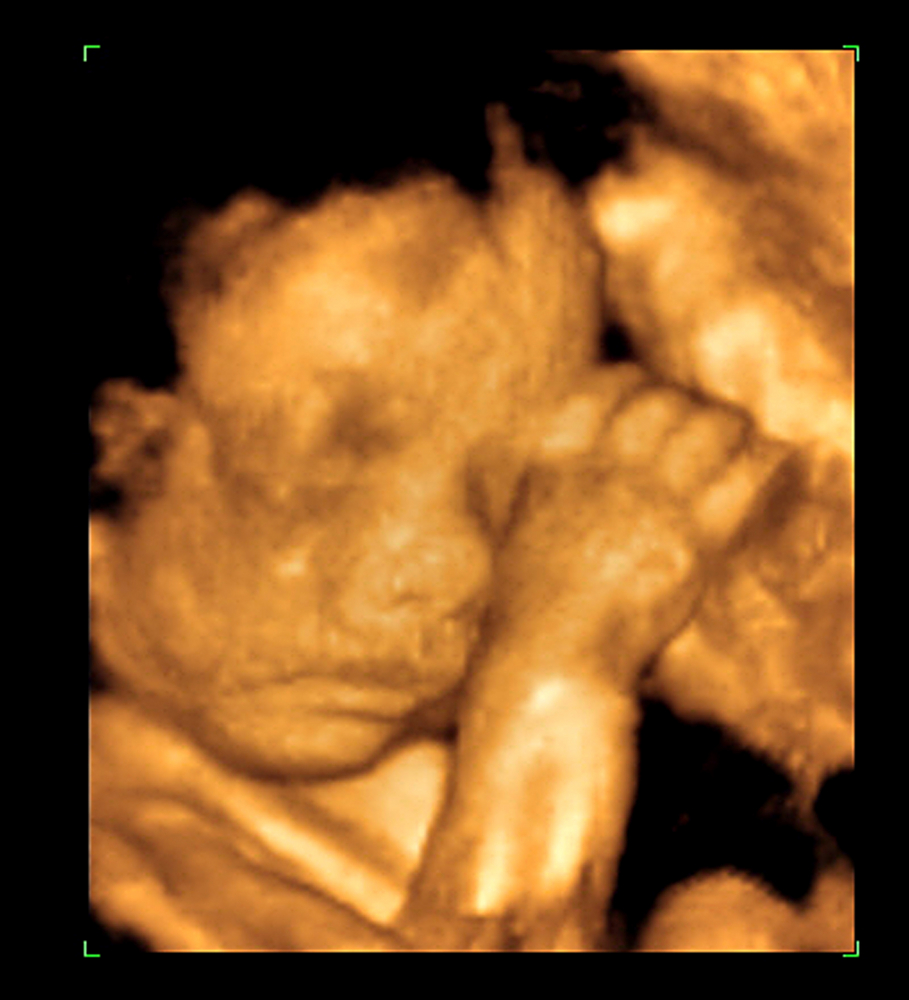This Isn’t a Photo After Birth – It’s a 3D Ultrasound Enhanced in 8K. Modern Tech Now Lets Parents Meet Their Baby Before Holding Them.

Close your eyes. Feel that? That’s your heartbeat syncing with another soul’s rhythm. The screen illuminates, and suddenly – revelation. Not a suggestion of life, but life itself in perfect detail. Those miniature hands that will one day hold yours, those lips that will first shape your name. This is no ordinary image. This is your first conversation with your child.
Science tells us bonding begins in these moments. Dr. Beatrice De Gelder, a leading neuroscientist studying prenatal connections, confirms: “When parents see their unborn child’s face, neural pathways for attachment activate powerfully.” You’re not just expecting anymore – you’re already parenting. Those 8K pixels? They’re simply catching up to what your heart already knows.
This changes everything. No more abstract waiting. No more imaginary faces. Just truth – radiant, intimate, undeniable. You haven’t just seen your baby. You’ve recognized them. And that recognition? That’s where love writes its first chapter.
Seeing Your Baby in Unimaginable Detail
We’ve all seen the traditional ultrasound pictures—the black-and-white grainy images of a tiny form curled up in the womb, often hard to make sense of. These images, while important, were far removed from the tangible connection we hoped to feel with our baby. But with 8K ultrasound technology, that all changes. The difference isn’t just in the clarity of the image—it’s in how we see our child, how we meet them before birth.
8K ultrasound technology is the next frontier in prenatal imaging, and it’s changing everything. Unlike traditional 2D ultrasounds, which offer only a flat, two-dimensional view, 8K imaging brings our baby’s features into hyper-realistic focus. The resolution is so high that it’s like looking at a high-definition photograph, one that captures the tiniest details: the curve of their nose, the subtle contours of their lips, even the soft texture of their skin.
In simple terms, 8K isn’t just about more pixels—it’s about seeing your baby in a way you never thought possible before. This is no longer a simple check-up; this is a window into the future. It’s not just about seeing their heart beating—it’s about seeing them yawn, stretch, or even smile in the womb.
This technology allows parents to not just hear a heartbeat, but to see it. They get to meet their baby face-to-face before they even hold them in their arms. For many parents, this experience shifts pregnancy from a waiting game to an ongoing emotional journey. It’s no longer a countdown to birth, but an immersive experience that begins the moment that first 8K image appears on the screen.
And for first-time parents, this can be nothing short of transformative. The experience becomes more than just a medical procedure; it becomes the first moment of connection. A moment where they’re no longer imagining what their baby might look like—they can see it, with startling clarity.
How This Changes the Pregnancy Experience
Pregnancy has often been seen as a time of waiting—waiting for the first kick, waiting for the first ultrasound, and ultimately, waiting for the birth. The journey was punctuated by milestones, but the moments between them felt like a blur. But now, with the advent of 8K ultrasound technology, waiting isn’t the word that should come to mind. Instead, it’s about experiencing—experiencing your baby, your child, long before the due date.
For the first time, expectant parents aren’t just looking at an image—they’re meeting a person. An unborn child, yes, but a person nonetheless, with a face, eyes, and expressions that hint at who they might be. It’s a surreal feeling. Imagine the awe of watching your baby’s face come to life in stunning detail, months before they’ll ever step into the world. That blurry black-and-white image that was once the standard? It’s now replaced by a vivid portrait of your child in the womb.
This transformation isn’t just about technology. It’s about shifting the entire perception of pregnancy. We’ve always known that babies grow and develop inside the womb, but now we can see it—and not just in vague terms, but with precision.
From the curve of their tiny nose to the way their lips form a perfect pout, every detail is visible. Parents can now witness their child’s movements: a yawn, a stretch, or even a smile. These aren’t just medical images—they’re intimate, living portraits.
For many parents, this kind of experience changes the emotional landscape of pregnancy. The joy of feeling the first kick is undeniable, but when you’re looking at your baby’s face in 8K resolution, it’s as if that connection happens on a deeper level. It’s no longer an abstract idea of “my baby”—you’ve seen them, you’ve met them, and you know them. That bond begins long before they take their first breath. It’s no longer about counting down the days to delivery—it’s about celebrating the moments that come with each ultrasound, each new image that shows you more of who your baby is.
And for parents who may have experienced losses or complicated pregnancies, these detailed images offer something deeply meaningful: reassurance. Seeing the baby’s face and knowing they are thriving can alleviate a lot of the uncertainty and fear that naturally accompany pregnancy. It gives them something concrete to hold onto, even as the rest of the journey may feel uncertain.
Sweet 3D Baby Ultrasound Studio: A Personalized Prenatal Experience
Sweet 3D Baby Ultrasound Studio in Brentwood, California, is redefining the way expecting parents experience ultrasound technology. Founded by Ericka Jordan, a skilled ultrasound technician, the studio offers 3D and 8K scans that allow families to see their baby in stunning detail before birth. What sets the studio apart is its focus on providing a personal, unrushed environment. Unlike traditional medical settings, where time is often limited, sessions at Sweet 3D Baby last 20 to 30 minutes, giving parents ample time to connect with their baby. This extended time makes the expeerience feel less clinical and more emotional, with parents able to watch their baby’s movements, yawns, or even smiles.
Ericka’s vision was to create more than just a diagnostic procedure; she wanted to give parents a meaningful, memorable experience. The studio’s relaxed atmosphere allows families to enjoy the moment without the usual pressures of a busy medical office.
Extended family members, like grandparents and siblings, are invited to join in, making it a shared experience that strengthens family bonds. Additionally, the studio offers keepsakes such as heartbeat bears and ultrasound picture frames, allowing parents to take home tangible memories of their ultrasound experience.
The growing popularity of 3D and 8K ultrasounds reflects a shift in how parents approach prenatal care. These advanced imaging options provide not only valuable medical insights but also emotional benefits. Parents can see their baby’s features in lifelike detail—sometimes months before birth—creating a deeper connection long before the baby is born. The clarity of 8K ultrasound images helps bring a sense of reality to the pregnancy, making it feel more tangible and real for parents.
Another reason for the rising demand for 3D/8K ultrasounds is the flexibility they offer. With evening and weekend appointments available, parents with busy schedules can easily fit an ultrasound session into their lives. Additionally, the opportunity to bring multiple family members along for the experience makes it even more inclusive. The combination of these personalized services and the option to preserve the moment with keepsakes has made Sweet 3D Baby Ultrasound Studio a popular choice for expecting families, offering a unique and memorable way to bond with their baby before birth.
Real Parents, Real Stories
While the technology behind 8K ultrasound is undeniably impressive, it’s the real-life stories of parents that show just how deeply this technology impacts their pregnancy journey. For many, these ultrasounds are more than just a way to check in on their baby’s growth—they are transformative experiences that allow them to connect with their child in ways that weren’t possible before.
Ericka Jordan, the founder of Sweet 3D Baby Ultrasound Studio, has witnessed this emotional connection firsthand. She often shares stories of parents who come into her studio, uncertain of what to expect, only to leave with a deep bond already formed. “It’s not just about getting a scan; it’s about creating memories,” says Ericka. For many parents, the 8K ultrasound isn’t just about medical data—it’s about seeing their baby’s face, watching them yawn, stretch, or even smile before they are born.
These moments leave lasting impressions. One parent described their experience of seeing their baby’s face in 8K resolution as “the most peaceful thing I’ve ever seen.” Another shared, “That’s when I really fell in love with them. Seeing them, right there on the screen, made everything feel so real.” These are not just images; they are memories that will be cherished long after the ultrasound appointment ends.
For parents like these, the 8K ultrasound is more than a medical necessity—it’s a way to create a deeper connection with their child before birth. It’s a chance to bond emotionally, share the experience with family members, and begin the journey of parenthood in an entirely new way.
How 8K Ultrasound Is Redefining Parenthood
The quiet revolution happening in ultrasound rooms worldwide isn’t about pixels or resolution—it’s about rewriting one of humanity’s most fundamental relationships. 8K ultrasound technology has transformed what was once a medical procedure into a profound human experience, bridging the gap between anticipation and connection in ways previously unimaginable.
This breakthrough goes far beyond clearer images. According to a 2024 Cambridge University study, parents who experienced high-definition ultrasounds showed neural bonding patterns nearly identical to those observed after physical birth. The implications are staggering: we’re not just seeing babies earlier—we’re forming relationships with them sooner. Neonatal psychologists now recognize this as “prenatal bonding acceleration,” where parent-child attachment begins months before delivery.
For families who’ve walked this path, the difference is transformative. “When we saw our daughter’s eyelashes at 28 weeks,” recalls David, a first-time father, “we didn’t just know she was healthy—we knew her.” These moments resonate particularly deeply for parents who’ve experienced previous loss, with 82% reporting the technology helped heal pregnancy-related anxiety (Journal of Maternal-Fetal Medicine, 2023).
What makes this evolution truly remarkable is its democratization of wonder. Where once only mothers could feel life stirring, now partners, grandparents, and siblings all share in these early meetings. Ultrasound images become family heirlooms—not just medical records, but the first photographs in a child’s life story.
As this technology becomes more accessible, we stand at the threshold of a new era in human connection. The ancient question—”When does parenthood begin?”—now has a revolutionary answer: The moment you truly see your child. And thanks to 8K ultrasound, that moment now comes when it matters most—at the very start of your journey together.
Featured Image Source: Shutterstock
Loading...






